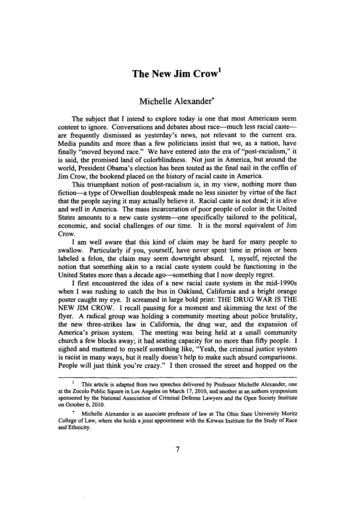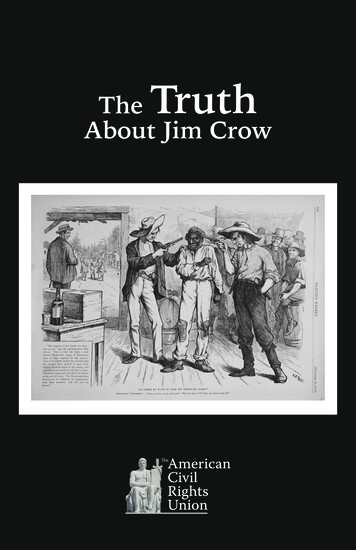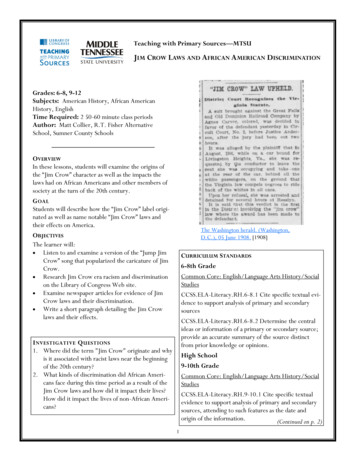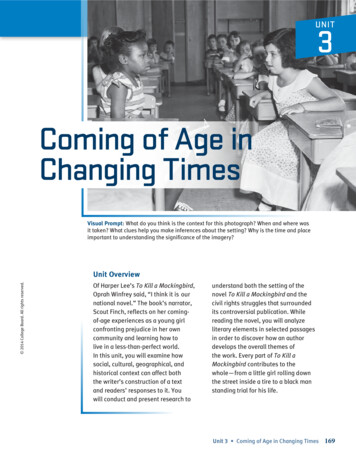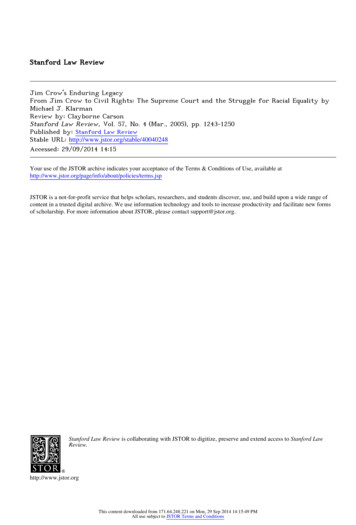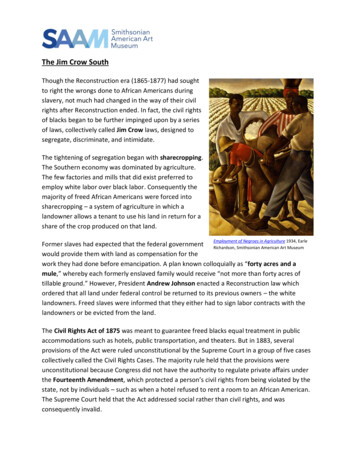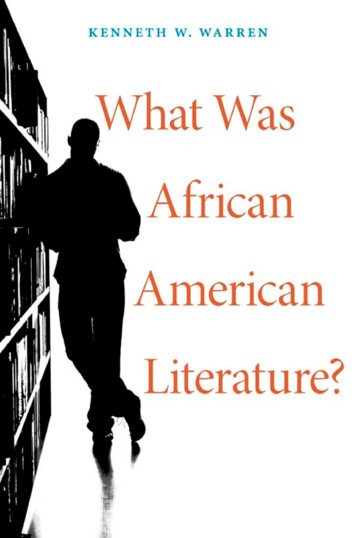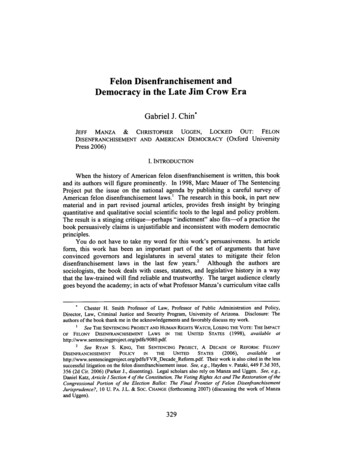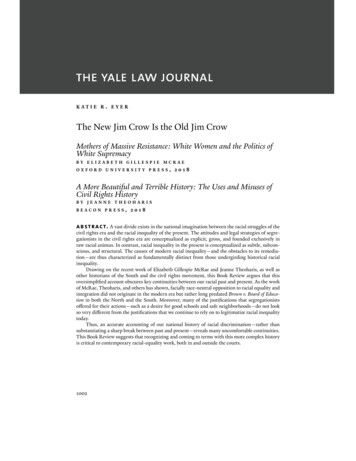
Transcription
KATIE R. EYERThe New Jim Crow Is the Old Jim CrowMothers of Massive Resistance: White Women and the Politics ofWhite SupremacyBY ELIZABETH GILLESPIE MCRAEOXFORD UNIVERSITY PRESS,2018A More Beautiful and Terrible History: The Uses and Misuses ofCivil Rights HistoryBY JEANNE THEOHARISBEACON PRESS,2018abstract. A vast divide exists in the national imagination between the racial struggles of thecivil rights era and the racial inequality of the present. The attitudes and legal strategies of segregationists in the civil rights era are conceptualized as explicit, gross, and founded exclusively inraw racial animus. In contrast, racial inequality in the present is conceptualized as subtle, subconscious, and structural. The causes of modern racial inequality—and the obstacles to its remediation—are thus characterized as fundamentally distinct from those undergirding historical racialinequality.Drawing on the recent work of Elizabeth Gillespie McRae and Jeanne Theoharis, as well asother historians of the South and the civil rights movement, this Book Review argues that thisoversimplified account obscures key continuities between our racial past and present. As the workof McRae, Theoharis, and others has shown, facially race-neutral opposition to racial equality andintegration did not originate in the modern era but rather long predated Brown v. Board of Education in both the North and the South. Moreover, many of the justifications that segregationistsoffered for their actions—such as a desire for good schools and safe neighborhoods—do not lookso very different from the justifications that we continue to rely on to legitimatize racial inequalitytoday.Thus, an accurate accounting of our national history of racial discrimination—rather thansubstantiating a sharp break between past and present—reveals many uncomfortable continuities.This Book Review suggests that recognizing and coming to terms with this more complex historyis critical to contemporary racial-equality work, both in and outside the courts.1002
the new jim crow is the old jim crowauthor. Professor of Law, Rutgers Law School. Many thanks to Elise Boddie, VinayHarpalani, Stacy Hawkins, Earl Maltz, Kim Mutcherson, Christopher Schmidt, Rick Swedloff,Anders Walker, Mary Ziegler, and participants in the Rutgers Legal History and Law and Societyaffinity group for helpful feedback and conversations regarding this project. This piece benefittedgreatly from the editorial suggestions of the editors of the Yale Law Journal, including especiallyDylan Shea Cowit. Finally, my sincerest thanks also to the generations of critical race scholarswhose work helped shape my understanding of the history recounted herein. Note that althoughthe title of this piece is an obvious allusion to the title of Michelle Alexander’s excellent book, TheNew Jim Crow, it is not primarily intended to be responsive to that book—and indeed, to the extentone major project of Alexander’s is to point out continuities between the past and the present, herwork is consonant with the observations made herein. However, to the extent that The New JimCrow, like many other sources, casts our racial history as focused on explicit Jim Crow laws andbigoted white Southerners, I view it as important to complicate those accounts for the reasonsdescribed herein.1003
the yale law journal128:10022019book review contentsintroduction1005i. theoharis, mcrae, and the rise of “the histories we need”1015ii. questioning the “redneckification of racism”1023iii. remembering “colorblind” jim crow1032iv. preservation through transformation1041v. taking disparate treatment seriously1053conclusion10751004
the new jim crow is the old jim crowintroductionOur nation’s canonical racial histories tell a story of dramatic change.1 Resistance to racial equality in the civil rights era (“old racism”) is conceptualized,as Jeanne Theoharis puts it, as “personal hatefulness . . . the governor snarlingat the University of Alabama entrance, the Mississippi voter registrar continuallyslamming the door on would-be Black voters, the white mother spitting at Blackchildren.”2 “New racism,” to the extent it is acknowledged to exist, is generallyperceived as subtle and perhaps even subconscious—different in quality andform from the racism of the past.3 In this telling, the civil rights movement—always respected (and respectable)—succeeded in its aims: dismantling the opensegregation of the Jim Crow South.4 The causes of modern racial inequality—and the obstacles to its remediation—are characterized as fundamentally distinctfrom those undergirding historical racial inequality.5A growing body of work by historians of the South and of the civil rightsmovement challenges this overly simplistic account and demonstrates that there1.2.3.4.5.As I discuss more fully below, I do not mean to suggest that everyone subscribes to this viewof the differences between contemporary and historical racial discrimination, nor that it is theonly extant narrative of the civil rights era. Rather, the perspective I describe as the “canonical,” “dominant,” or “popular” account of the civil rights era is simply the stock story thatframes many contemporary discussions of race and informs the perspective of, in particular,many everyday white Americans. Notably, the power of these stock stories is demonstratedby the fact that they have at times framed the statements and work of even those who aresurely aware of the stories’ oversimplified and potentially misleading nature. See infra note 33and accompanying text.JEANNE THEOHARIS, A MORE BEAUTIFUL AND TERRIBLE HISTORY: THE USES AND MISUSES OFCIVIL RIGHTS HISTORY 84 (2018).See EDUARDO BONILLA-SILVA, RACISM WITHOUT RACISTS: COLOR-BLIND RACISM AND THEPERSISTENCE OF RACIAL INEQUALITY IN AMERICA 2-4 (2014) (drawing sharp distinctions between the racism of the present and the racism of the past); Susan Sturm, Second GenerationEmployment Discrimination: A Structural Approach, 101 COLUM. L. REV. 458, 460 (2001) (arguing that “[c]ognitive bias, structures of decisionmaking, and patterns of interaction have replaced deliberate racism and sexism as the frontier of much continued inequality”). But cf.Jessica A. Clarke, Explicit Bias, 113 NW. U. L. REV. 505 (2018) (arguing for renewed scholarlyattention to continued forms of “old” explicit bias in the present). Note that this Review doesnot contend that there has not been any evolution in the forms that racism takes, but simplythat the break between those forms in our past and present is far less sharp than it is oftencharacterized as being.See THEOHARIS, supra note 2, at 3-27.See id.; see also Sturm, supra note 3.1005
the yale law journal128:10022019is far less discontinuity between the past and the present than we6 might like tobelieve.7 As these historians have shown, resistance to racial equality during thecivil rights era took many forms—of which explicit Jim Crow-style statutes and6.7.A word on my use of pronouns is in order. As described later in the Introduction, this Reviewis directed predominantly at the self-perception and racial understandings of white Americans. Thus, when I use the terms “us” and “we,” I am directing my commentary at that subgroup, of which I am a member. Many of the simplistic histories—and accounts of the present—that the work of the historians described herein challenges are not ones that mostpeople of color would endorse. Cf. Russell K. Robinson, Perceptual Segregation, 108 COLUM. L.REV. 1093 (2008) (extensively describing divides between how whites and racial minoritiesperceive racial discrimination).For additional recent historical literature complicating this oversimplified account, see also,for example, R. SCOTT BAKER, PARADOXES OF DESEGREGATION: AFRICAN AMERICAN STRUGGLES FOR EDUCATIONAL EQUITY IN CHARLESTON, SOUTH CAROLINA, 1926-1972 (2006); JOSEPHCRESPINO, IN SEARCH OF ANOTHER COUNTRY: MISSISSIPPI AND THE CONSERVATIVE COUNTERREVOLUTION (2007); ESSAYS IN TWENTIETH-CENTURY SOUTHERN EDUCATION: EXCEPTIONALISM AND ITS LIMITS (Wayne J. Urban ed., 1999); KEVIN M. KRUSE, WHITE FLIGHT: ATLANTA AND THE MAKING OF MODERN CONSERVATISM (2005); MATTHEW D. LASSITER, THESILENT MAJORITY: SUBURBAN POLITICS IN THE SUNBELT SOUTH (2006); JAMES W. LOEWEN,SUNDOWN TOWNS: A HIDDEN DIMENSION OF AMERICAN RACISM (2005); NANCY MACLEAN,FREEDOM IS NOT ENOUGH: THE OPENING OF THE AMERICAN WORKPLACE (2006); THE MODERATES’ DILEMMA: MASSIVE RESISTANCE TO SCHOOL DESEGREGATION IN VIRGINIA (MatthewD. Lassiter & Andrew B. Lewis eds., 1998) [hereinafter THE MODERATES’ DILEMMA]; THEMYTH OF SOUTHERN EXCEPTIONALISM (Matthew D. Lassiter & Joseph Crespino eds., 2010);CHRISTOPHER W. SCHMIDT, THE SIT-INS: PROTEST AND LEGAL CHANGE IN THE CIVIL RIGHTSERA (2018); THOMAS J. SUGRUE, SWEET LAND OF LIBERTY: THE FORGOTTEN STRUGGLE FORCIVIL RIGHTS IN THE NORTH (2008); ANDERS WALKER, THE BURNING HOUSE: JIM CROW ANDTHE MAKING OF MODERN AMERICA (2018) [hereinafter WALKER, THE BURNING HOUSE]; andANDERS WALKER, THE GHOST OF JIM CROW: HOW SOUTHERN MODERATES USED BROWN V.BOARD OF EDUCATION TO STALL CIVIL RIGHTS (2009) [hereinafter WALKER, THE GHOST OF JIMCROW]. Articles also contributing to a richer understanding are too numerous to list, but arecited where relevant. Note of course that many critical race scholars have also long made similar arguments about continuity between our racial past and present, which, as I discuss laterin the Review, are deeply consonant with the recent work of historians (and especially theconclusions that can be drawn from them). See, e.g., DERRICK BELL, FACES AT THE BOTTOM OFTHE WELL: THE PERMANENCE OF RACISM 3, 98 (1992) [hereinafter BELL, FACES AT THE BOTTOM OF THE WELL]; Derrick Bell, Foreword: The Final Civil Rights Act, 79 CALIF. L. REV. 597,597 (1991) [hereinafter Bell, Final Civil Rights Act]. There is also a recent burgeoning literatureoffering more complicated accounts of the civil rights movement itself, which, apart fromTheoharis’s book, I do not address here.1006
the new jim crow is the old jim crowpractices were but one.8 Even before Brown v. Board of Education,9 opponents ofdesegregation and racial equality—both Southern and Northern—had embracedostensibly “race neutral” measures and rhetoric to entrench racial inequalitywhere open racial discrimination was no longer sanctioned.10 As “massive resistance”11 collapsed, race-neutral12 approaches became the dominant frame forresistance to racial equality in the South—just as they had long been in theNorth.13Historians have also, by offering a much richer account of opponents of desegregation and other racial-equality measures, complicated perceptions of suchopponents as uniformly the product of raw racial animus. While, to be sure, racial animus played a substantial role in opposition to the civil rights movement,many opponents—in both the North and the South—perceived themselves to beacting for “good” reasons—reasons they did not see as reflecting racial hatred.14Rather, many of the tropes invoked by segregationists and other opponents of8.9.10.11.12.13.14.See infra Part III. Scholarship addressing the phenomenon of nonfacial forms of racial discrimination—during both the Jim Crow and civil rights eras—of course existed even prior tothe recent historical scholarship described herein. But recent scholarship, such as AndersWalker’s excellent book The Ghost of Jim Crow, has given special attention to the importanceof attending to the continuity that such forms of nonfacial racial discrimination create betweenour present and our past. See generally WALKER, THE GHOST OF JIM CROW, supra note 7 (extensively discussing this issue).347 U.S. 483 (1954).See infra Part III.The “absolute defiance” response to Brown—openly refusing to admit African American children to “white” schools—is typically referred to as “massive resistance.” See Judith A. Hagley,Massive Resistance—The Rhetoric and the Reality, 27 N.M. L. REV. 167, 170 (1997). As discussedin Part II, although massive resistance is often conceptualized as being the general responseof the Southern states during the earliest years following Brown, see id., several Southernstates, from the start, took a covert obstructionist approach. As massive resistance collapsedin the late 1950s and early 1960s, this became the dominant approach to resisting Brown. Seeinfra Part II.I use the term “race neutral” throughout this piece to describe laws, rhetoric, or beliefs thatare characterized as, or are perceived to be, unrelated to racial disparate treatment. As described at greater length herein, such characterizations and self-perceptions may be sincere orinsincere—but in either instance may be false, insofar as many “race-neutral” laws, rhetoric,and beliefs, historically and today, are in fact racially discriminatory.See infra Part II.See id. Of course, this was true even regarding slavery, which many contemporaneous whitesviewed as beneficial to both blacks and whites. See John W. Wertheimer, 36 LAW & HIST. REV.186 (2018) (reviewing ALFRED L. BROPHY, UNIVERSITY, COURT, AND SLAVE: PRO-SLAVERYTHOUGHT IN SOUTHERN COLLEGES AND COURTS AND THE COMING OF THE CIVIL WAR (2016)).1007
the yale law journal128:10022019racial equality—of black criminality and dangerousness, of black students’ academic unpreparedness, of property rights, and of safe neighborhoods—wereperceived by opponents as reflecting real concerns.15 Thus, many opponents ofdesegregation would have perceived little resemblance between themselves andthe animus-driven archetype of segregationist resistance—just as many whiteAmericans today perceive themselves as fundamentally dissimilar from segregationists of the civil rights era.Elizabeth Gillespie McRae’s Mothers of Massive Resistance and Theoharis’s AMore Beautiful and Terrible History are both welcome additions to the burgeoninghistorical literature complicating the distance we seek to place between our racialpast and present. McRae’s Mothers of Massive Resistance places white women atthe center of efforts to maintain white supremacy in the Jim Crow South, tracingthe complex and evolving ways that white women and mothers sought to preserve racial privilege.16 By following a core group of white women activists in theera leading up to and after Brown, McRae shows the evolving rhetoric and strategies of opposition to desegregation and its increasing representation in “colorblind”17 frames.18 By demonstrating how these women integrated themselvesinto a national conservative movement—and undertook the work of reproducing15.See infra Part II. In this Review, I repeatedly identify the specific racial stereotypes held bywhite Americans historically and today—something that may seem jarring in today’s era of“colorblind” discourse. To be clear, I do so neither to suggest that such stereotypes are true(though as I point out, it is important to understanding racism that segregationists then andnow have believed them to be), nor to suggest that their embrace is not racist. Rather, thepurpose of my discussion of racial stereotypes is intended to highlight a point that other scholars have also previously observed: their capacity to obscure, for those who hold them, a selfawareness of their own racism. See generally Charles R. Lawrence III, The Id, the Ego, and EqualProtection: Reckoning with Unconscious Racism, 39 STAN. L. REV. 317 (1987) (seminal articlemaking this point).Some might question the need to repeatedly name these stereotypes, and might believethat doing so in some way gives them credence. That is a reasonable perspective, though certainly not my intent. My own perspective is that we cannot effectively counteract racism without being willing to explicitly say its name and identify its manifestations. Indeed, if the purpose of revisiting our histories is to encourage white Americans to interrogate their own racialbiases by helping them see continuity with the past, we cannot hope to do that without naming with specificity which racial stereotypes—past and present—continue to undergird contemporary racism.16. ELIZABETH GILLESPIE MCRAE, MOTHERS OF MASSIVE RESISTANCE: WHITE WOMEN AND THEPOLITICS OF WHITE SUPREMACY 4 (2018).17. “Colorblind,” as used herein, refers to measures, rhetoric, or beliefs that are facially race neutral. As described at greater length in this Review, such measures need not be truly race neutraland indeed often are not. See also supra note 12 (describing the use of the term “race neutral”in this Review).18. See MCRAE, supra note 16, at 4-19.1008
the new jim crow is the old jim crowracial hierarchy in innumerable localized and private ways not touched by thelaw—McRae’s work suggests why it would be facile to assume that formal legalequality has undone the structures of racial hierarchy.19Theoharis’s A More Beautiful and Terrible History similarly complicates ourtriumphalist perception of the civil rights era, taking on both sides of our oversimplified account. As Theoharis persuasively demonstrates, the civil rightsmovement itself was neither so beloved in its own time nor so domesticated ascontemporary accounts would suggest. Martin Luther King, Jr., opposed discrimination, segregation, and police brutality in both the North and the South—and for this reason, among others, was widely unpopular with white Americansat the time of his death.20 Robust grassroots civil rights movements existed inboth the North and the South, and challenged forms of segregation and discrimination that are, in many regards, strikingly similar to those we live with today.21Just as the Black Lives Matter movement is today subjected to criticism by multiple constituencies, the civil rights movement was criticized by both whites andsome blacks as pushing too hard, using unlawful and disruptive methods, andseeking to introduce dangerous and damaging reforms.22On the other side, Theoharis demonstrates how our triumphalist narrativeof the civil rights movement dovetails with our flattened, animus-focused account of the actions of segregationists. Theoharis shows how our caricatured account of opponents of desegregation—what she refers to as “the redneckificationof racism”—melds with our accounts of the civil rights movement to allow us toimagine ourselves as much further removed than we actually are from the racial19.See id.20. See THEOHARIS, supra note 2, at 3-4, 9-10, 63-64; Black Lives Matter, INFLUENCE ck-lives-matter[https://perma.cc/9YZP-37DM] (collecting sources describing criticisms of the Black Lives Matter movement).21. See THEOHARIS, supra note 2, at 31-98.22. See id. at 22-26. For example, as Theoharis and others have pointed out, the pervasive critiquesthat have been leveled against the forms of protest employed by the Black Lives Matter movement are hardly novel. Though the civil disobedience of the civil rights movement is todayremembered with reverence, in its own time, it was often criticized as dangerous, disruptive,un-American, and illegal. See id. at 23-26, 173-86; Anders Walker, A Lawyer Looks at Civil Disobedience: Why Lewis F. Powell Jr. Divorced Diversity from Affirmative Action, 86 U. COLO. L.REV. 1229, 1230-31 (2015); see also Steve Chapman, Opinion, Why Do Whites Oppose the NFLProtests?, CHI. TRIB. (Sept. 26, 2017, 3:40 PM), story.html [https://perma.cc/K5EM-D8SR] (observing that, then and now, white Americans view unfavorablyeven peaceful, lawful protests by African Americans). But cf. SCHMIDT, supra note 7, at 91-113(describing the heterogeneity of the responses to sit-in protests, even among opponents).1009
the yale law journal128:10022019inequality of the past.23 Rather, many opponents of desegregation during thecivil rights era deployed familiar and often ostensibly race-neutral frames to resist meaningful desegregation.24 As Theoharis suggests, it is only through ourmythologization and flattening of both the civil rights movement and its opponents that we can perceive our racial present as fundamentally disconnected fromour racial past.Drawing on the work of Theoharis and McRae—as well as that of other historians—this Book Review makes the case that recapturing these more complicated accounts of our racial past is critical to the racial-equality work of the present.25 As the work of Theoharis, McRae, and others demonstrates, it is onlythrough highly selective memorialization that we can claim a clear break fromthe structures and ideologies of racial subordination that existed in the civilrights era. And yet this distance is what allows us to exculpate ourselves from theracial inequality of the present.26 Fully embracing our complicated racial historythus has important implications for contemporary race equality work both insideand outside of the courts.In law, in particular, embracing these more complicated histories calls uponus to reimagine the doctrine at the heart of contemporary antidiscriminationlaw: disparate treatment. With a fuller understanding of the motives and selfperception of racial-justice opponents, it is readily apparent why the “intent”proxy that the Supreme Court often uses for disparate treatment is inadequate.Rather, disparate treatment doctrine must, in fact, focus on disparate treatment:the ways in which racial minorities continue to be treated differently across ahost of domains. So too history suggests an important role in disparate treatment doctrine for stereotypes, which have long undergirded the justifications forracial inequality, and for skeptical consideration of facially race-neutralmeasures, which have served as a form of “colorblind” Jim Crow for 150 years.23.THEOHARIS, supra note 2, at 83-99.Id. at 62-99.25. Note that this Book Review, because it is centered on our national histories of the civil rightsmovement and responses to Brown in the South, focuses on African Americans. However,much of the discussion could also pertain to other complicated histories—and important implications of those histories—that we ought to consider regarding other racial and ethnic minority groups in our country. Certainly, the recommendations of Part V, although framed interms of African Americans, should extend to adjudication of discrimination against all racialand ethnic minority groups, and indeed arguably to all protected groups generally.26. Cf. Elise C. Boddie, The Contested Role of Time in Equal Protection, 117 COLUM. L. REV. 1825,1826 (2017) (making a similar observation in relation to the Supreme Court’s jurisprudenceand its propensity to “obscure the relationship between present-day racial inequality and pastdiscrimination,” and calling for greater historical inquiry as an aid to adjudicating discrimination in equal protection jurisprudence).24.1010
the new jim crow is the old jim crowThis Review proceeds in five Parts. Part I introduces A More Beautiful andTerrible History and Mothers of Massive Resistance more fully. It then situates themwithin the broader body of historical work calling into question our standardaccounts of the civil rights era. As this Part lays out, Theoharis’s and McRae’sbooks are important new additions to an outpouring of contemporary historicalscholarship that challenges virtually every aspect of our standard accounts of thecivil rights era, and in so doing should complicate our understandings of ourracial past and present.Part II turns to an in-depth discussion of one of the most substantial contributions of the historical literature in this area, complicating our unidimensionalaccounts of opponents of desegregation and other civil rights measures. As historians such as Theoharis, McRae, and others have shown, our caricature of segregationists as exclusively motivated by raw racial animus and exclusively locatedwithin the South has caused us largely to overlook the wide array of actors thatopposed desegregation and the many reasons they put forward. Moreover, manyof those reasons—such as worries about school quality, stereotypes about themorals and academic unpreparedness of African American students, and concerns regarding state erosion of parental control—look not so very different fromthose widely embraced today. Thus, the work of historians—by affording greaternuance and complexity to our understandings of who opposed desegregationand why—fundamentally problematizes the distance we place between ourselvesand historical opponents of racial equality.Part III turns to the historical work that demonstrates that not only the perspectives, but also the forms, of legal discrimination in the Jim Crow era are notso very distant from our present. Drawing on the work of Theoharis andMcRae—as well as others, such as Anders Walker27—this Part shows that whileJim Crow laws were one piece of the framework of racial subordination in theyears before Brown, they were far from the only piece. In both the North and theSouth, ostensibly race-neutral devices were used to maintain segregation andother forms of racial subordination both before and after Brown. This Part explores how our story of a triumphant civil rights movement that defeated legalized racism becomes far more complicated if one acknowledges the diversity offorms legal opposition to racial equality took, even during the civil rights eraitself.Part IV takes up the constitutional doctrines that grew out of Brown—“colorblindness” and intent doctrine—and describes why both, while well intentioned,27.For relevant works by Walker, see, for example, WALKER, THE GHOST OF JIM CROW, supranote 7, as well as the articles cited infra note 121.1011
the yale law journal128:10022019ultimately proved inadequate to the task of eradicating racial inequality.28 As thisPart explores, the close work of historians gives us an up-front view of the process that Reva Siegel has referred to as “preservation-through-transformation”—the preservation of status regimes in the face of legal reform.29 As thework of contemporary historians has shown, there are striking similarities between the forms of and justifications for opposition to civil rights after Brownand the forms of and justifications for opposition to civil rights today. Thus, thework of historians shows just how little “transformation” was required for important aspects of the pre-Brown racial regime to endure.Finally, Part V explores the implications of the foregoing discussion for contemporary society and equality law. As this Part explores, the work of historiansought to profoundly shape how we view our modern structures of racial inequality—as well as our own comfortable understanding of such structures as raceneutral and justified. In the case of equality law, the work of historians calls uponus to take seriously the ways that contemporary antidiscrimination doctrine predictably fails to achieve even its core anti-disparate-treatment mission and to recommit ourselves to that disparate treatment mission through historically informed doctrinal reform. Most fundamentally, adopting a more accurate,historically informed understanding of how racial disparate treatment occursmakes clear why disparate treatment itself—rather than its traditional proxy, discriminatory intent—must form the fundamental inquiry in equality law.30 Thework of historians provides the tools for such a refocused disparate treatment28.I interrogate in this Book Review the tendency to characterize ourselves as far removed fromthe structures and ideologies of racial subordination that existed in the civil rights era. In particular, I suggest that continuities with the past should cause us to reassess whether we canassure ourselves with confidence that the anti-disparate-treatment mission of contemporaryequality law is being met. Of course, even if disparate treatment were entirely eradicated today, racial inequality would remain, as other scholars have persuasively shown. See generallyDARIA ROITHMAYR, REPRODUCING RACISM: HOW EVERYDAY CHOICES LOCK IN WHITE ADVANTAGE (2014) (extensively documenting how racial inequality reproduces itself even in theabsence of disparate treatment). Thus, my arguments should not be taken to suggest that thework of historians that complicates our understandings of racial bias—or the prescriptive suggestions regarding disparate treatment that I derive therefrom—entirely explains or addressescontemporary racial inequality.29. See Reva Siegel, Why Equal Protection No Longer Protects: The Evolving Forms of Status-Enforcing State Action, 49 STAN. L. REV. 1111, 1119 (1997); see also Elise C. Boddie, Adaptive Discrimination, 94 N.C. L. REV. 1235 (2016) (articulating a similar theory and describing the ways thatracial discrimination has evolved to survive in the face of legal and social change).30. I do not mean to suggest here that disparate treatment should be the only actionable paradigmin equality law, but rather that as to our core disparate treatment commitment, disparate treatment itself—rather than discriminatory intent—ought to be at the heart of the inquiry. Forstatutory antidiscrimination law, it remains the case that disparate impact is, and ought to be,another available paradigm.1012
the new jim crow is the old jim crowinquiry, reminding us that the faces of contemporary racism are often not so verydifferent from those of our past.***A few final observations are important before proceeding to the substance ofthis Review. First, while the work of historians that I describe herein may bevaluable to a variety of audiences, its most vital audience—and that to which Iaddress myself most directly here—is white Americans. Although, as other excellent work has shown, not all causes of racial subordination derive from theactions of the white community,31 the central call of the history described hereinis for those of us who are its racial descendants to understand how it may implicate us. Thus, when I use the terms “we” and “us,” I am referring primarily topeople (like myself) wh
the new jim crow is the old jim crow 1005 introduction Our nation’s canonical racial histories tell a story of dramatic change.1 Re-sistance to racial equality in the civil rights era (“old racism”) is conceptualized, as Jeanne Theoharis puts
